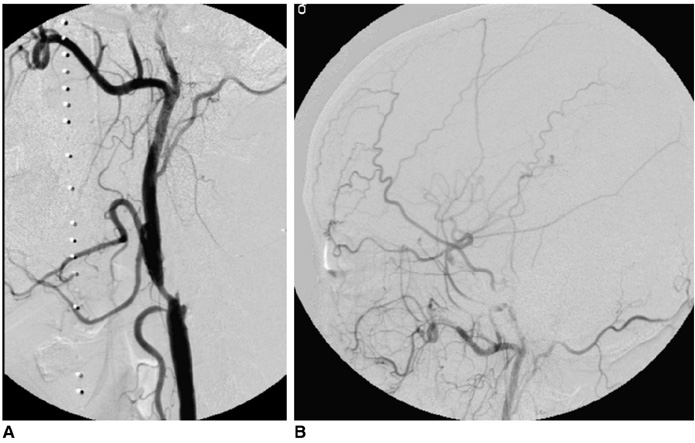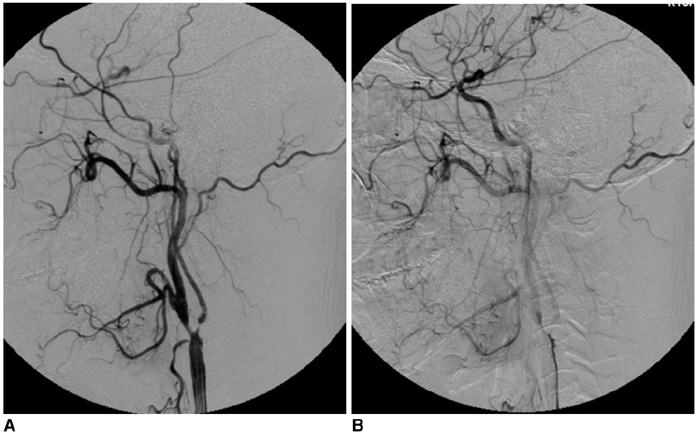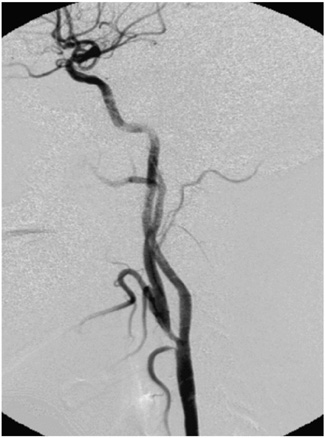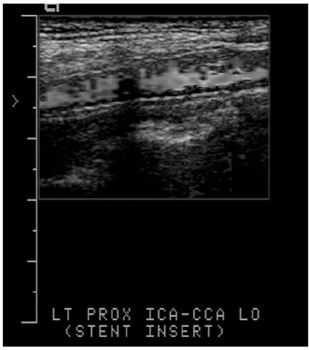Korean J Radiol.
2006 Dec;7(4):292-296. 10.3348/kjr.2006.7.4.292.
Carotid Artery Stenting in a Patient with Spontaneous Recanalization of a Proximal Internal Carotid Artery Occlusion: a Case Report
- Affiliations
-
- 1Department of Diagnostic Radiology, Kyung Hee University Medical Center, Seoul, Korea. euijkim@yahoo.co.kr
- 2Department of Neurosurgery, Kyung Hee University Medical Center, Seoul, Korea.
- KMID: 1092554
- DOI: http://doi.org/10.3348/kjr.2006.7.4.292
Abstract
- We report here on a rare case of carotid artery angioplasty and stenting in a patient with spontaneous recanalization after complete occlusion of the proximal internal carotid artery (ICA). The patient initially showed severe stenosis at the left proximal ICA on MR angiography (MRA). Digital subtraction angiography (DSA) performed three days after MRA showed complete occlusion of the proximal ICA. The follow-up DSA after four weeks showed recanalization of the ICA, and then carotid artery stenting was successfully performed. There has been no neurologic complication during more than one year follow-up.
Keyword
MeSH Terms
Figure
Cited by 1 articles
-
Total Occlusion of the Internal Carotid Artery by Subacute In-Stent Thrombosis and Subsequent Spontaneous Recanalization After Stent-Assisted Coil Embolization
Cheol Young Lee, Chang-Woo Ryu, Jun Seok Koh, Eui Jong Kim
Neurointervention. 2011;6(1):38-41. doi: 10.5469/neuroint.2011.6.1.38.
Reference
-
1. Meyer FB, Sundt TM Jr, Piepgras DG, Sandok BA, Forbes G. Emergency carotid endarterectomy for patients with acute carotid occlusion and profound neurological deficits. Ann Surg. 1986. 203:82–89.2. Meves SH, Muhs A, Federlein J, Buttner T, Przuntek H, Postert T. Recanalization of acute symptomatic occlusions of the internal carotid artery. J Neurol. 2002. 249:188–192.3. Nguyen-Huynh MN, Lev MH, Rordorf G. Spontaneous recanalization of internal carotid artery occlusion. Stroke. 2003. 34:1032–1034.4. Bogousslavsky J, Despland P-A, Regli F. Spontaneous carotid dissection with acute stroke. Arch Neurol. 1987. 44:137–140.5. Steinke W, Rautenberg W, Schwartz A, Henerici M. Noninvasive monitoring of internal carotid artery dissection. Stroke. 1994. 25:998–1005.6. Sturzenegger M, Mattle HP, Rivoir A, Baumgartner RW. Ultrasound findings in carotid artery dissection: Analysis of 43 patients. Neurology. 1995. 45:691–698.7. Pryor JC, Setton A, Nelson PK, Berenstein A. Complications of diagnostic cerebral angiography and tips on avoidance. Neuroimaging Clin N Am. 1996. 6:751–758.8. Ringlelstein EB, Biniek R, Weiller C, Ammeling B, Nolte PN, Thron A. Type and extent of hemispheric brain infarctions and clinical outcome in early and delayed middle cerebral artery recanalization. Neurology. 1992. 42:289–298.9. Wholey MH, Al-Mubarek N, Wholey MH. Updated review of the global carotid artery stent registry. Catheter Cardiovasc Interv. 2003. 60:259–266.10. Malek AM, Higashida RT, Phtouros CC, Lempert TE, Meyers PM, Smith WS, et al. Stent angioplasty for cervical artery stenosis in high-risk symptomatic NASCET-ineligible patients. Stroke. 2000. 31:3029–3033.
- Full Text Links
- Actions
-
Cited
- CITED
-
- Close
- Share
- Similar articles
-
- Spontaneous Recanalization from Traumatic Internal Carotid Artery Occlusion
- Aspiration Clot Removal by Mannual Compression of Common Carotid Artery for Acute Internal Carotid Occlusion: a Case Report
- A Case of Transseptal Approach to Carotid Artery Stenting in Right Internal Carotid Stenosis
- Ophthalmic Artery Occlusion After Carotid Revascularization
- Retinal Artery Occlusion after Carotid Angioplasty and Stenting: A Case Report






